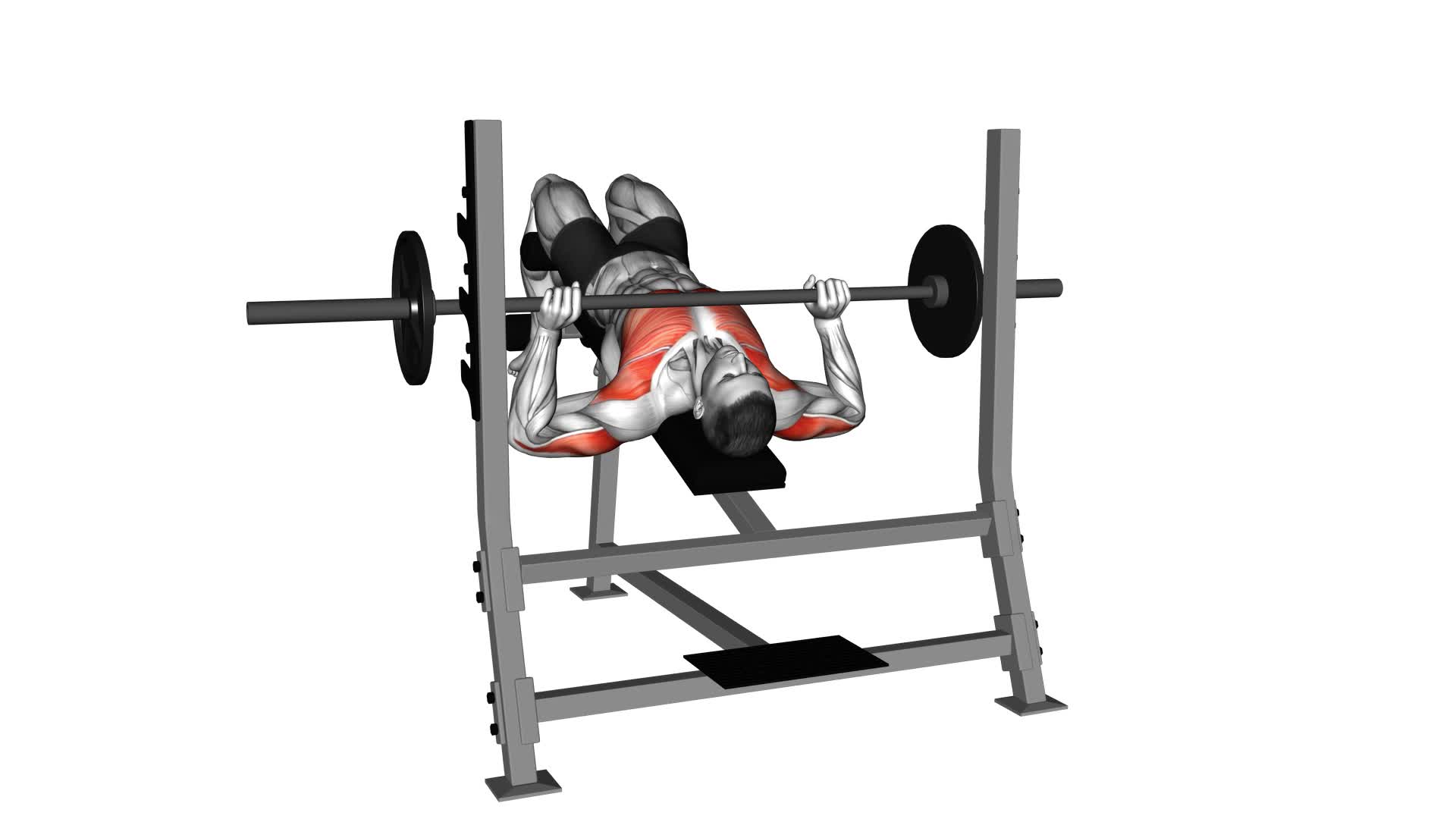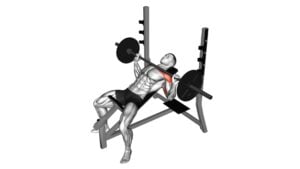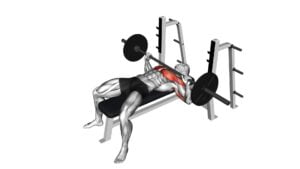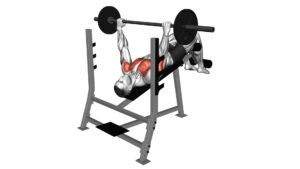Barbell Pause Decline Bench Press – Video Exercise Guide & Tips

Are you looking to take your bench press to the next level?
Watch This Exercise Video
Then the Barbell Pause Decline Bench Press is the exercise for you.
By incorporating a pause at the bottom of the movement, you'll build strength and increase muscle activation.
In this video exercise guide, we'll show you the proper form and technique, as well as provide tips to challenge yourself and avoid common mistakes.
Get ready to see impressive gains with the Barbell Pause Decline Bench Press.
Key Takeaways
- Targets lower chest muscles
- Builds overall upper body strength
- Increases muscle activation in the lower chest
- Maximizes tension on muscles for greater gains in strength and size
Benefits of Barbell Pause Decline Bench Press
Experience the powerful benefits of the Barbell Pause Decline Bench Press for targeting your lower chest muscles and building overall upper body strength. This exercise provides increased muscle activation in the lower chest, making it an effective way to develop and strengthen that specific area. By incorporating a pause at the bottom of the movement, you're able to maximize tension on the muscles, leading to greater gains in strength and size.
Additionally, the Barbell Pause Decline Bench Press is a fantastic exercise for improving shoulder stability. The decline angle of the bench places more emphasis on the lower chest and shoulders, forcing them to work harder to stabilize the weight. This not only helps to prevent injury, but also enhances your overall upper body strength and performance in other compound movements.
To perform the Barbell Pause Decline Bench Press, lie on a decline bench with your feet secured and grasp the barbell with a grip slightly wider than shoulder-width apart. Lower the barbell slowly to your lower chest, pause for a moment, and then press it back up explosively.
Incorporating the Barbell Pause Decline Bench Press into your workout routine will yield noticeable improvements in lower chest development, increased muscle activation, and improved shoulder stability.
Proper Form and Technique for Barbell Pause Decline Bench Press
To properly execute the Barbell Pause Decline Bench Press, you should begin by positioning yourself on a decline bench with your feet secured and gripping the barbell slightly wider than shoulder-width apart. This exercise is beneficial for increasing strength and muscle activation in the chest, shoulders, and triceps.
Once in position, lower the barbell slowly and under control towards your chest, allowing it to touch your sternum. Pause for a brief moment, holding the weight in this bottom position. This pause is important as it enhances muscle activation and increases the difficulty of the exercise.
Next, drive the barbell back up explosively, using the strength of your chest, shoulders, and triceps. Be sure to maintain proper form throughout the movement, with your back and core engaged and your elbows tucked close to your body.
It is important to note that the decline bench angle targets the lower portion of the chest and adds an additional challenge to the exercise. To get the most out of this exercise, focus on maintaining a controlled and steady tempo, emphasizing proper form and technique.
With consistent practice, the Barbell Pause Decline Bench Press can help you build strength and increase muscle activation in your upper body.
Tips to Increase Intensity and Challenge Yourself
To maximize the effectiveness of the Barbell Pause Decline Bench Press, consistently challenge yourself by gradually increasing the weight and frequency of your training sessions. One way to modify the exercise and increase intensity is by adding resistance bands or chains to the barbell. This will provide variable resistance throughout the movement, making it more challenging.
Another modification is to incorporate supersets into your workout routine. This involves performing a different exercise immediately after completing a set of Barbell Pause Decline Bench Press. For example, you can superset with push-ups or dips to target your chest and triceps even more. By incorporating supersets, you not only increase the intensity of your workout but also save time by working multiple muscle groups at once.
Remember to listen to your body and gradually progress. Increasing the weight too quickly or overtraining can lead to injury. As you become stronger, challenge yourself by adding more weight or increasing the number of sets and reps. This will ensure that you continue to make progress and see results.
Now, let's move on to the next section where we'll discuss common mistakes to avoid during the Barbell Pause Decline Bench Press.
Common Mistakes to Avoid During Barbell Pause Decline Bench Press
To avoid common mistakes during the Barbell Pause Decline Bench Press, ensure proper form and technique. Proper form is crucial to maximize the effectiveness of this exercise and prevent injury.
One common mistake is arching your back excessively. While a slight arch is acceptable, excessive arching can strain your lower back and compromise your form. Keep your back flat on the bench throughout the movement.
Another mistake to avoid is gripping the barbell too wide or too narrow. A wide grip can put unnecessary strain on your shoulders, while a narrow grip may limit your range of motion. Find a grip width that allows you to maintain proper form and comfortably lower the barbell to your chest.
It's also important to maintain control and avoid bouncing the barbell off your chest. This not only diminishes the effectiveness of the exercise but also increases the risk of injury. Instead, pause momentarily at the bottom of the movement before pressing the barbell back up.
Variations and Progressions for Barbell Pause Decline Bench Press
Continue to challenge yourself and make progress with the Barbell Pause Decline Bench Press by incorporating variations and progressions into your training routine.
Adding variations to your Barbell Pause Decline Bench Press can help target different muscle groups and prevent plateaus in your training. One variation you can try is the Close Grip Barbell Pause Decline Bench Press, where you bring your hands closer together on the barbell. This variation places more emphasis on your triceps and can help improve lockout strength.
Another variation is the Wide Grip Barbell Pause Decline Bench Press, where you widen your grip on the barbell. This targets your chest muscles more effectively.
Additionally, you can incorporate pause training into your Barbell Pause Decline Bench Press. Pausing at the bottom of the movement for a few seconds can increase time under tension and enhance muscle recruitment. This can lead to greater strength gains and hypertrophy.
Remember to start with lighter weights when incorporating variations and progressions, and gradually increase the intensity as you become more comfortable and confident with the exercises.
Frequently Asked Questions
How Many Reps and Sets Should I Do for the Barbell Pause Decline Bench Press?
To determine the optimal weight and form for the barbell pause decline bench press, you should start by experimenting with different weights that challenge you while maintaining proper form. Gradually increase the weight as you become more comfortable and confident.
To incorporate this exercise into a chest-focused workout routine, perform 3-4 sets of 8-12 reps. Remember to rest for about 1-2 minutes between sets to allow for recovery.
Can Beginners Perform the Barbell Pause Decline Bench Press?
Yes, beginners can perform the barbell pause decline bench press.
It's important for beginners to focus on proper form when performing this exercise. Make sure to start with a weight that you can handle comfortably and gradually increase as you gain strength.
Avoid common mistakes such as arching your back or bouncing the weight off your chest.
Take your time and pause at the bottom of the movement to maximize muscle engagement.
Can the Barbell Pause Decline Bench Press Help With Building a Stronger Chest?
Yes, the barbell pause decline bench press can definitely help you build a stronger chest.
By incorporating pause training, where you hold the weight at the bottom of the movement, you increase time under tension and activate more muscle fibers.
This exercise targets the lower chest and triceps, improving overall chest strength and size.
With consistent training and proper form, you'll reap the benefits of pause training and see significant gains in your chest muscles.
Should I Use a Spotter While Performing the Barbell Pause Decline Bench Press?
When performing the barbell pause decline bench press, it's recommended to use a spotter for added safety and support. A spotter can help you lift heavier weights and ensure proper form, reducing the risk of injury.
Without a spotter, you may be at a higher risk of dropping the barbell, which can lead to accidents. It's always better to be safe than sorry, so consider having a spotter present during your workouts.
Are There Any Alternatives to the Barbell Pause Decline Bench Press for Targeting the Lower Chest Muscles?
If you're looking for alternative exercises to target your lower chest muscles, there are a few options you can try. Push-ups with your feet elevated or using a decline bench can help engage those muscles.
Dips and chest flyes are also effective for targeting the lower chest.
By focusing on these exercises, you can increase muscle strength and definition in that area.
Conclusion
In conclusion, the barbell pause decline bench press is a highly effective exercise that targets the chest, shoulders, and triceps.
By following proper form and technique, you can maximize the benefits of this exercise and avoid common mistakes.
Additionally, incorporating variations and progressions can help to increase intensity and challenge yourself.
Remember to always listen to your body and consult with a fitness professional if needed.
Keep pushing yourself and enjoy the results of this challenging exercise.

Author
Years ago, the spark of my life’s passion ignited in my mind the moment I stepped into the local gym for the first time. The inaugural bead of perspiration, the initial endeavor, the very first surge of endorphins, and a sense of pride that washed over me post-workout marked the beginning of my deep-seated interest in strength sports, fitness, and sports nutrition. This very curiosity blossomed rapidly into a profound fascination, propelling me to earn a Master’s degree in Physical Education from the Academy of Physical Education in Krakow, followed by a Sports Manager diploma from the Jagiellonian University. My journey of growth led me to gain more specialized qualifications, such as being a certified personal trainer with a focus on sports dietetics, a lifeguard, and an instructor for wellness and corrective gymnastics. Theoretical knowledge paired seamlessly with practical experience, reinforcing my belief that the transformation of individuals under my guidance was also a reflection of my personal growth. This belief holds true even today. Each day, I strive to push the boundaries and explore new realms. These realms gently elevate me to greater heights. The unique combination of passion for my field and the continuous quest for growth fuels my drive to break new ground.







